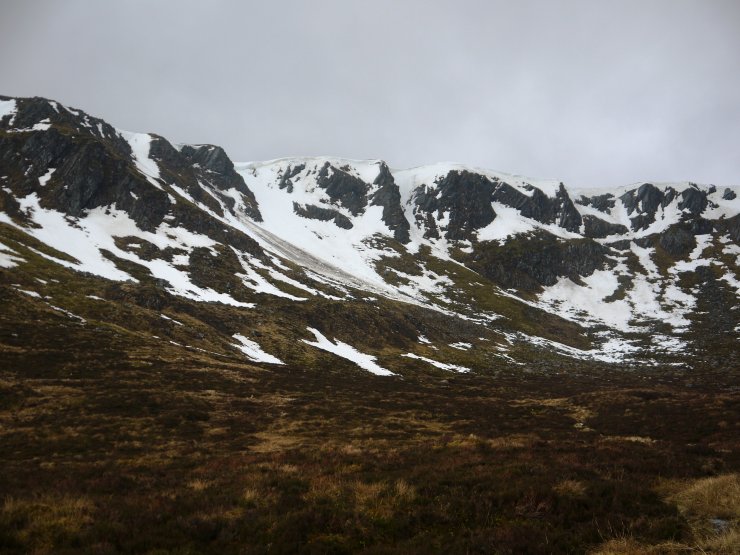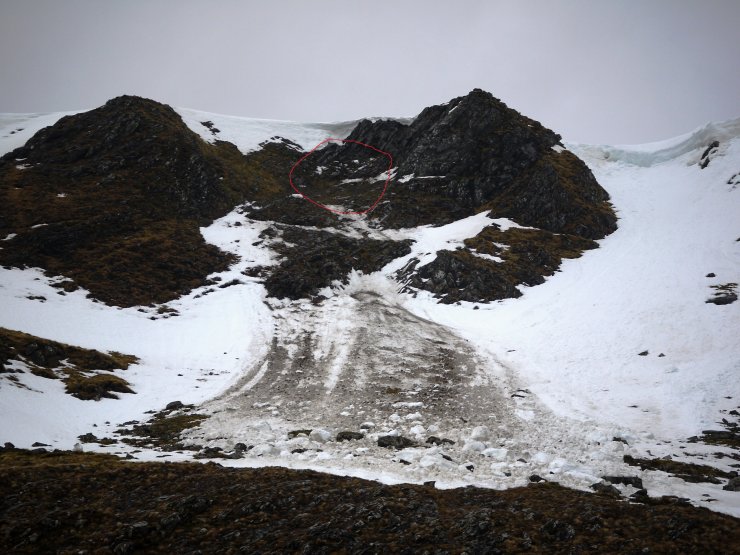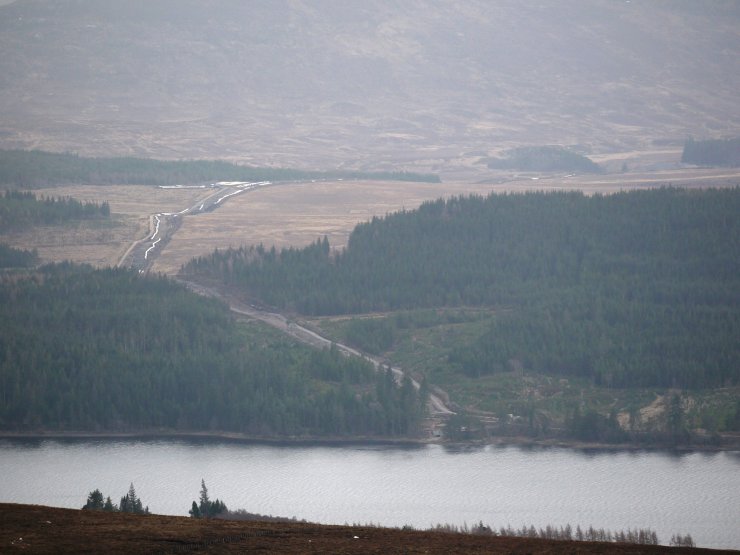Coire Dubh
25th January 2017
 (Above) Ventured into Coire Dubh today for a look at the debris from last Saturday’s full depth avalanche. Coire Dubh is one of the relatively deeply incised coires on the SW flank of the Carn Liath massif.
(Above) Ventured into Coire Dubh today for a look at the debris from last Saturday’s full depth avalanche. Coire Dubh is one of the relatively deeply incised coires on the SW flank of the Carn Liath massif.
 (Above) The avalanche was about 20m across in the start zone and ran out about 125m with the debris fan widening in the lower reaches. The larger blocks at the toe of the debris are about 1.5m³, big enough to infer some cornice involvement – perhaps the trigger? The area outlined in red was where snow was seen last Friday and although it doesn’t show up in the photo there’s been some ground surface scouring in the start zone as well. The large stone blocks in the toe of the avalanche run out zone were found to be part of pre-existing talus deposits near the bottom of the crag. Still a few old cornices around, too.
(Above) The avalanche was about 20m across in the start zone and ran out about 125m with the debris fan widening in the lower reaches. The larger blocks at the toe of the debris are about 1.5m³, big enough to infer some cornice involvement – perhaps the trigger? The area outlined in red was where snow was seen last Friday and although it doesn’t show up in the photo there’s been some ground surface scouring in the start zone as well. The large stone blocks in the toe of the avalanche run out zone were found to be part of pre-existing talus deposits near the bottom of the crag. Still a few old cornices around, too.
 (Above) The view from Coire Dubh across Loch Laggan. The earthworks and piping are part of the River Pattack new hydro scheme.
(Above) The view from Coire Dubh across Loch Laggan. The earthworks and piping are part of the River Pattack new hydro scheme.
The other micro-hydro schemes in the area utilise ‘river-run’ water to generate electricity. The Pattack scheme is storage-based and will entail the construction of a dam part way up the River Pattack which, once commissioned, will produce 9MW of ‘on-demand’ electricity (about 25GWh total per year on average). The dam will have a crest length of circa 125m and be about 18m high, creating a reservoir of 0.15km². The pipe visible in the photo is 2m in diameter and when complete will be buried and be 6.5km in length. During the construction phase the pipeline will require a ‘working corridor’ of up to 40m wide in order to position, join and bury the pipe.
There’s a lot of concrete being poured into some of our remote glens in the pursuit of ‘green’ energy.
Comments on this post
Got something to say? Leave a comment




North Col
26th January 2017 10:17 am
If you think that’s bad, you should see what’s going on at Attadale – landscape ‘rearrangement’ and habitat destruction on a scale worthy of Brazilian logging operations. (Not to mention the vandalism being perpetrated at Loch Glass side of Wyvis, Mullardoch, Coulin (Torridon), Brunery (Moidart)… the list seems endless. This dash to trash wild areas somewhat undermines the allegedly sustainable credentials of this type of development. Unfortunately, it has to take something as catastrophic as destruction of a freshwater pearl mussel colony before any sanctions are brought – and even then it’s just a few thousand quid fine – loose change to the developers.
meagaidhadmin
26th January 2017 3:08 pm
Mountaineering Scotland seem to be taking quite an interest in this sort of issue re. Glen Etive mobile phone mast & wind farms et al.
The general public have been quite animated about the landscape and local scale environmental impacts of on-shore wind farms but, as yet, haven’t picked up on the 1000 year legacy of concrete hydro structures (+ their access tracks) in remote and wild places.
The ‘un-wilding’ of the Scottish Highlands seems to an incremental process that nobody really notices until it’s too late, and then it really is too late to do anything about it.
Many thanks for your comment.
Leeds Lad
26th January 2017 3:44 pm
I wont forget my last trip up the glen leading from Glenfinnan to Knoydart. A vast construction site for several kilometres to put in a ‘green’ hydro scheme.. The formerly beautiful, historic glen had been devastated. Apparently the end pipework was to be buried. This was a few years ago and I haven’t been back, but some serious cosmetic surgery would have been required to fix the damage, which would be a challenge in any environment, let alone the West Highlands. Perhaps it is all fixed up and looks pristine now, but at the time it was shocking.
I’m glad you mentioned this issue and hope it is picked up by MCoS.
meagaidhadmin
26th January 2017 4:44 pm
Unfortunately, the landscape in these glens is mute and has almost no lobby because few people live there. They’re remote, too, so most outsiders don’t notice them either like they would a skyline full of wind turbines. The low-carbon lobby is strong and has the ear of most of the politicians. The whole industry was supported by public subsidy (our taxes) but this is now at an end. The ending of the Feed-in-Tariff Scheme on 1st October 2015 has put the brakes on future hydro developments and induced a lot of financial uncertainty for micro-hydro developers.
Perhaps the remaining wild places will experience some peace for a year or two? However, I fear the next publicly-funded ‘green’ energy bonanza isn’t far away.
Many thanks for your comment.
matt dalby
26th January 2017 10:13 pm
Unfortunately this “green energy” madness is sanctioned by the Scottish Government in pursuit of a low carbon future (despite the fact that many schemes involve as many emissions during construction as they will save in their operating lifetime). It’s the Tory government at Westminster that is trying to put the brakes on this kind of development by cutting subsidies. Another independence referendum anyone?
It is also true that a lot of these schemes will be getting subsidies under various EU clean energy mandates, who says that Brexit is a bad idea?
An argument that I have often heard in support of renewables is that fossil fuels are a finite resource so we can’t go on using them for ever. When will these people realise that relatively unspoilt landscapes are also a finite resource?
meagaidhadmin
26th January 2017 10:24 pm
Thanks for your comment, Matt. Hope you don’t mind me highlighting your final sentence.